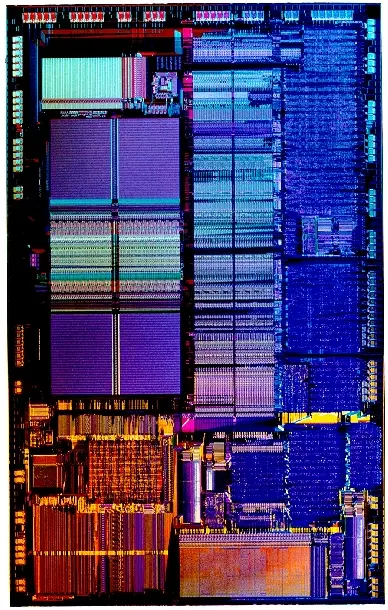From WikiChip
Difference between revisions of "intel/microarchitectures/80486"
| (5 intermediate revisions by 4 users not shown) | |||
| Line 1: | Line 1: | ||
{{intel title|80486|arch}} | {{intel title|80486|arch}} | ||
{{microarchitecture | {{microarchitecture | ||
| − | | | + | | atype = CPU |
| name = 80486 | | name = 80486 | ||
| designer = Intel | | designer = Intel | ||
| Line 11: | Line 11: | ||
| process 2 = 800 nm | | process 2 = 800 nm | ||
| process 3 = 600 nm | | process 3 = 600 nm | ||
| + | |isa=x86-32 | ||
| succession = Yes | | succession = Yes | ||
| Line 21: | Line 22: | ||
}} | }} | ||
'''80486''' was the [[microarchitecture]] for [[Intel]]'s {{intel|80486}} line of microprocessors as a successor to the {{\\|80386}}. Introduced in April of 89, 80486 was initially manufactured using [[1 µm process]] (later [[800 nm]]). For AMD, this microarchitecture was used for their {{amd|Am486}} and {{amd|Am5x86}} families. This architecture was superseded by Intel's {{\\|P5}} in 1992 and {{amd|microarchitectures/k5|K5}} in 1994. | '''80486''' was the [[microarchitecture]] for [[Intel]]'s {{intel|80486}} line of microprocessors as a successor to the {{\\|80386}}. Introduced in April of 89, 80486 was initially manufactured using [[1 µm process]] (later [[800 nm]]). For AMD, this microarchitecture was used for their {{amd|Am486}} and {{amd|Am5x86}} families. This architecture was superseded by Intel's {{\\|P5}} in 1992 and {{amd|microarchitectures/k5|K5}} in 1994. | ||
| + | |||
| + | == History == | ||
| + | {{empty section}} | ||
| + | |||
| + | == Process Technology == | ||
| + | {{empty section}} | ||
| + | |||
| + | == Architecture == | ||
| + | |||
| + | === Key changes from {{\\|80386}} === | ||
| + | * Testability | ||
| + | ** [[JTAG]] interface support (Std. 1149.1-1990) | ||
| + | |||
| + | == Die Shot == | ||
| + | * [[1 µm process]] | ||
| + | * 1,200,000 transistors | ||
| + | [[File:486dx die shot.png]] | ||
Latest revision as of 18:34, 30 November 2017
| Edit Values | |
| 80486 µarch | |
| General Info | |
| Arch Type | CPU |
| Designer | Intel |
| Manufacturer | Intel, AMD |
| Introduction | April 10, 1989 |
| Phase-out | 1995 |
| Process | 1 µm, 800 nm, 600 nm |
| Instructions | |
| ISA | x86-32 |
| Succession | |
80486 was the microarchitecture for Intel's 80486 line of microprocessors as a successor to the 80386. Introduced in April of 89, 80486 was initially manufactured using 1 µm process (later 800 nm). For AMD, this microarchitecture was used for their Am486 and Am5x86 families. This architecture was superseded by Intel's P5 in 1992 and K5 in 1994.
History[edit]
| This section is empty; you can help add the missing info by editing this page. |
Process Technology[edit]
| This section is empty; you can help add the missing info by editing this page. |
Architecture[edit]
Key changes from 80386[edit]
- Testability
- JTAG interface support (Std. 1149.1-1990)
Die Shot[edit]
- 1 µm process
- 1,200,000 transistors
Facts about "80486 - Microarchitectures - Intel"
| codename | 80486 + |
| designer | Intel + |
| first launched | April 10, 1989 + |
| full page name | intel/microarchitectures/80486 + |
| instance of | microarchitecture + |
| instruction set architecture | x86-32 + |
| manufacturer | Intel + and AMD + |
| microarchitecture type | CPU + |
| name | 80486 + |
| phase-out | 1995 + |
| process | 1,000 nm (1 μm, 0.001 mm) +, 800 nm (0.8 μm, 8.0e-4 mm) + and 600 nm (0.6 μm, 6.0e-4 mm) + |
